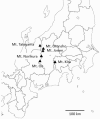Cecal Microbiome Analyses on Wild Japanese Rock Ptarmigans (Lagopus muta japonica) Reveals High Level of Coexistence of Lactic Acid Bacteria and Lactate-Utilizing Bacteria
- PMID: 30060588
- PMCID: PMC6164970
- DOI: 10.3390/microorganisms6030077
Cecal Microbiome Analyses on Wild Japanese Rock Ptarmigans (Lagopus muta japonica) Reveals High Level of Coexistence of Lactic Acid Bacteria and Lactate-Utilizing Bacteria
Abstract
Preservation of indigenous gastrointestinal microbiota is critical for successful captive breeding of endangered wild animals, yet its biology is poorly understood. Here, we compared the cecal microbial composition of wild living Japanese rock ptarmigans (Lagopus muta japonica) in different locations of Japanese mountains, and the dominant cecal microbial structure of wild Japanese rock ptarmigans is elucidated. Coriobacteraceae and Lachnospraceae were the two dominant bacterial families in all samples analyzed. At the genus level, 10 genera Olsenella, Actinomyces, Megasphaera, Slackia, Cloacibacillus, Bifidobacterium,Escherichia,Dialister, Megamonas, and Bilophila were dominant. These results reveal the high level of coexistence of lactic acid bacteria (Olsenella and Bifidobacterium) and lactate-utilizing bacteria (Megasphaera). This coexistence should be taken into account for the successful breeding of captive Japanese rock ptarmigans in the national conservation program.
Keywords: Bifidobacterium; Japanese rock ptarmigan; Lagopus muta japonica; Megasphaera; Olsenella; cecal microbiome.
Conflict of interest statement
The authors declare no conflicts of interest.
Figures






References
-
- Suzuki A., Kobayashi A., Nakamura H., Takasu F. Population viability analysis of the Japanese rock ptarmigan Lagopus muta japonica in Japan. Wildl. Biol. 2013;19:339–346. doi: 10.2981/13-021. - DOI
-
- Nakamura H. Rock Ptarmigan Lagopus mutus japonicus. Jpn. J. Ornithol. 2007;56:93–114. doi: 10.2326/jjo.56.93. - DOI
-
- Ministry of the Environment, Government of Japan 2012 National Conservation Program for Japanese Rock Ptarmigans. [(accessed on 25 July 2018)]; Available online: https://www.env.go.jp/nature/kisho/hogozoushoku/pdf/jigyoukeikaku/raicho....
LinkOut - more resources
Full Text Sources
Other Literature Sources

